The Ultimate Beginner’s Guide to Trend Trading
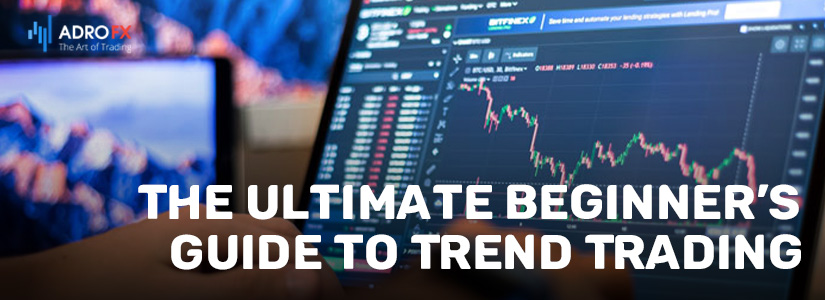
Forex trend trading is exactly the way many traders use to make a profit on the currency exchange. Trend trading has many advantages: the ability to take a large number of pips due to a strong, directional price movement, a high probability of profit, and good accuracy of signals. These are the reasons that allow traders to use trend trading effectively.
Let's consider the basic algorithm of trend trading to learn how to make the most of the price movement and make minimum mistakes, which, no matter how hard one tries, will still happen from time to time.
What is a Trend?
A trend involves a tendency for price to rise or fall over some time. There are two types of trends - bullish and bearish.
In a bullish trend, the price makes high bases and higher tops. Thus, the trend line during a bullish trend acts as support.
Bearish trends are the opposite of bullish trends. In this case, creates lower highs and lower lows on the chart. In this case, the bearish trend line can be drawn through the highs.
There are various trend indicators, but one of the easiest and most effective ways to analyze trends is to use trend lines.
A trend line is a diagonal line on a chart that connects several peaks or bases on the chart. The main function of a trend line is to act as support or resistance for price movement.
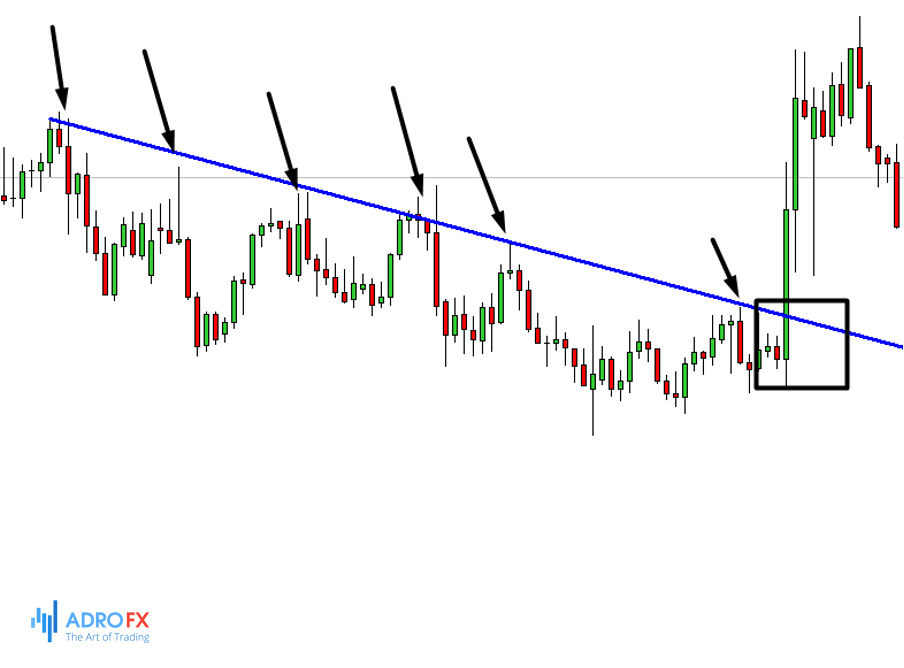
We see a bearish trend line that acts as a resistance line when the price is moving down. The arrows point to places where the price is testing the trend line as resistance. On the seventh price interaction with the bear trend, we get a bullish breakout. Price closes above the bearish trend line, implying that the trend is broken out and price direction is likely to change.
In a trending market, two types of systematic price movements are important for understanding the trend. These two types of price movements are called momentum and corrections.
A trend momentum is a price movement that occurs after interacting with a trend line and after the price bounces in the direction of the trend. Trend momentum leads to large price movements over a relatively shorter period.
Corrective price movements follow the momentum and return the price to the trend. A correction on the chart is not as attractive to trade. Traders without sufficient trading experience should stay out of the market when the price is in a correction phase. The reason for this is that corrections are relatively smaller and often last longer than momentum.
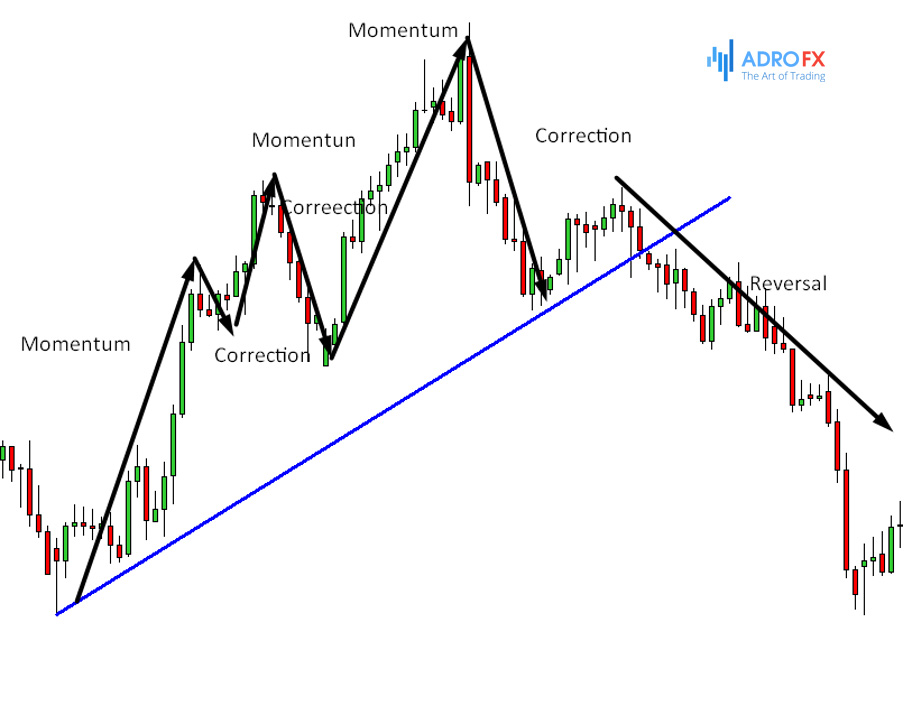
As you can see, price registers higher highs and higher lows, indicating that there is a bullish trend on the chart. Note that trend momentum leads to relatively large price movements in the direction of the trend. The third correction on the chart has about the same duration as the last momentum and later leads to a trend breakout.
How Do You Find Trends?
We already know that an uptrend consists of ascending highs and lows. And a downtrend consists of descending highs and lows.
But what if you see a chart that looks like this?
Is it the end of a downtrend and the beginning of an uptrend? Or is the price in a trading range? There is a problem in determining trends if you use higher highs and lows - this approach will always be subjective. So use a 200-period Moving Average (MA) to determine exactly what the trend is in the market right now.
Depending on the time frame, the market can move in different trends.
Downtrend on a weekly chart.
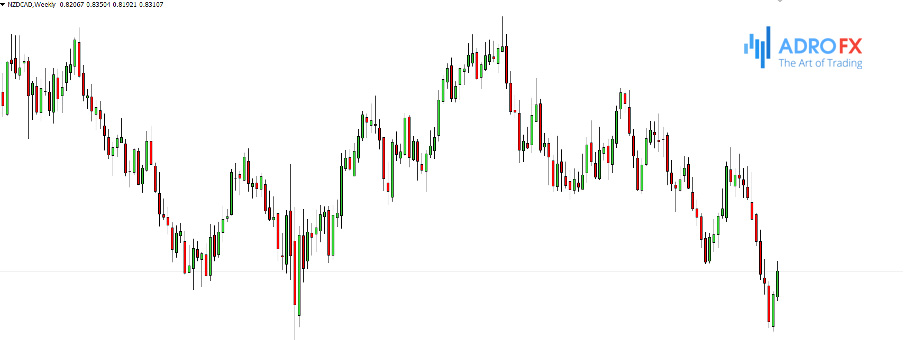
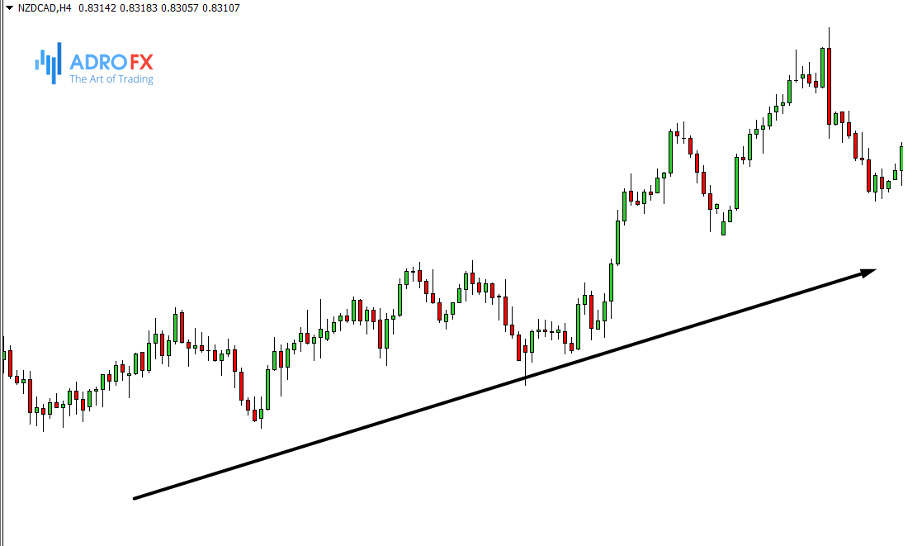
It would be a mistake to try to trade trends in different time frames. Instead, focus only on the main time frame and trade only in it. However, your trend trading can improve if you analyze charts of different time frames.
Benefits of Trend Trading?
Trading with the trend increases the percentage of your profitable trades, gives a good risk to reward ratio, and can be used in any market and in any time frame.
Let's take a chart with points a, b, c, d, and e.

Look at the price movement and ask yourself: do you want to buy at points c, d, or e? Or go short at points a or b. Most likely, you will prefer points c, d, or e, because one look at the chart makes it clear that long positions will have a better chance of success.
Trends not only increase your chances of making money on price movements but also allow you to enter the market with a good risk to reward ratio. Countertrend movements are always weaker than trend movements, and if you manage to enter at the beginning of a trend or on its continuation, you will make good profits with little risk.
Suppose you set small profit targets but use a very large Stop Loss or no Stop Loss at all. This will cause you to take frequent profits, but a few bad trades will significantly reduce your trading account.
However, if you use a small Stop Loss and do not limit your profits, you will have frequent losses. That said, just one trade will be able to compensate you for all the losses you incurred and bring in substantial profits.
What types of trends are there?
Most traders believe that a trend consists of higher highs and lows. But that's not enough, because trends come in all kinds of forms. Some are better to trade with breakout strategies and some are better to enter only on pullbacks. There are three types of trending markets, which we will get to know.
Strong Trends
Buyers control the price and it is moving steadily upwards, there is only a little pressure from the sellers. This type of trend will have small pullbacks - around the 20MA level. In some cases, this type of trend will be so strong that it will move up without any pullbacks.
It will not be easy to enter this type of trend because corrections will be too weak or there will not be any. So the best thing would be to try to catch this type of trend at the beginning of its movement and enter it on its breakdown. If the trend has already gained strength, it is possible to switch to a smaller time frame and look for entry points on the pullback there.
Regular Trends
Buyers are still in control of the price, but sellers are more active. This is due to someone locking in their profits or entering against the trend. This type of trend will have pullbacks to the 50 MA level.
Regular trends can also be entered on a level breakout, but you must be prepared psychologically to withstand a possible strong pullback to the broken level. You can always enter this type of trend later on its pullback to 50 MA.
Weak Trends
Buyers and sellers are fighting for control, with the buyers slowly starting to gain the upper hand. Price will move in large pullbacks beyond the 50 MA.
Soon the previous trend may change direction. Therefore, the best strategy is to enter the market at support and resistance levels.
Where Should I Place a Stop Loss in Trend Trading?
There are three logical places to place Stop Loss in trend trading: behind the Moving Averages, behind the previous pullback, and the dynamic trend lines.
Moving Averages
In a market with a strong trend, the price tends not to go over 20 MA. Thus, you should put your Stop Loss below 20MA.
If the trend is calmer and does not go behind the 50 MA, place your Stop behind the 50 MA line.
Previous pullback
You can always place a Stop Loss below the boundary of the previous pullback of the trend.
Trend lines
To avoid false triggering of your Stops, you can use the technique of placing a Stop Loss at a distance of one or two ATRs from the Moving Averages, the previous pullback, or the trend lines. Then your potential losses can increase, but your Stops will be well protected from accidental price spikes.
Peculiarities of Trend Trading
Before you start trend trading, you must first recognize a potential trend. Experienced traders will tell you that "The trend is your friend!" because the profits from a trending instrument are much higher and such trades can involve less risk. Let's discuss a few trading techniques for potential trends on the chart.
As we already know, if the highs and lows of price are rising, we are in a bullish trend. If the highs and lows are decreasing, we are in a bearish trend. In all other cases, we have no trend conditions.
Every two points on the chart can be connected by a straight line. However, if the third point is on the same line, then we have a trend. Thus, trend confirmation usually comes after price tests the trend at the third touch and bounces off of it. When you see the bounce, you can enter the market trying to catch the new trend.
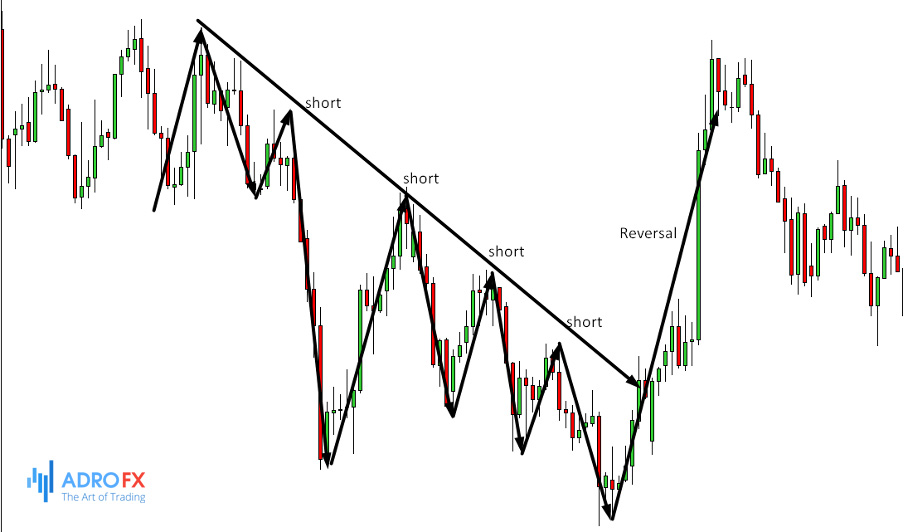
The first two arrows point to the tops of the trend. These are the first two points used to draw the trend line. Now we will sit back and wait for the third price interaction. Next, we notice a strong bearish response from the trend line. This will be considered our confirmation of the trend and will prepare us for a short position. The fourth arrow confirms the trend. Thus, the return and rebound from the trend line give us another trading opportunity.
Trend Trading and Trading Volume
Volumes are useful for identifying new trends. The reason for this is that in many cases price starts trending up after volume increases. Thus, impulse trend movements appear during high trading volumes. Corrections, on the other hand, appear when trading volumes decrease. When volumes are high, there is a lot of activity in the market. Thus, high volumes give an idea of momentum waves occurring.
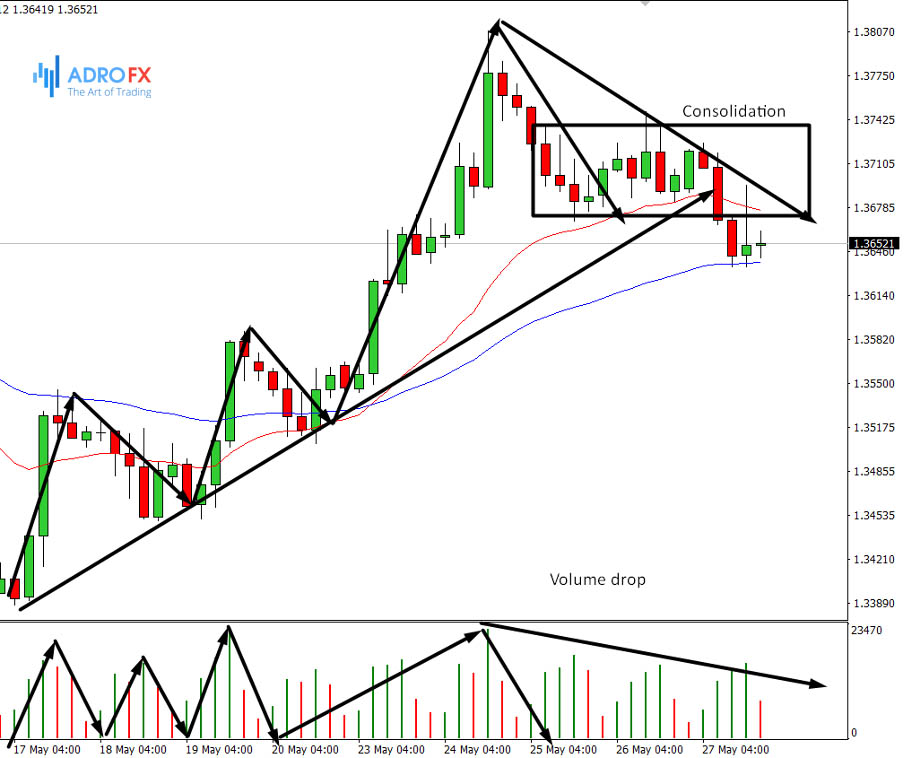
This time you see a volume indicator. Note that trading volumes are largely responsive to momentum and corrections, as shown by the arrows above. At the same time, when volumes begin to fall, we see price enter a consolidation phase, which subsequently leads to a breakout in a bullish trend.
Different Approaches to Trend Trading
Trend trading can be divided into two approaches:
- Systematic trading;
- Discretionary trading.
Systematic trading
Systematic trading clearly defines all the rules you must follow in your trading: entry point, profit taking place, risk management, and trade management.
Most of these actions can be automated by building automated models that are based on technical analysis with limited intervention by the trader. This approach is widely used by large hedge funds.
The trader can only determine the level of risk and markets to be traded.
Discretionary Trading
Discretionary trading has less clear-cut rules that a trader must follow. This approach requires constant participation in trades and is widely used by individual traders. Although discretionary trading is more subjective, it is still based on a trading plan.
Trend Trading Strategy
A trading strategy for trend trading is only 1/3 of the component of your success. Without proper risk management and discipline, even the best trading strategy will not help you trade profitably.
- To develop a trend trading strategy for yourself, you will have to answer the following questions:What time frame will I use?
- What will be my risk level for each trade?
- What markets will I trade?
- Where will be my entry point?
- Where will I exit if the price goes against my position?
- Where will I take my profits if the price goes my way?
In practice, it would look something like this:
- If the price is above the 200 Moving Average, the trend is uptrending.
- In an uptrend, we expect two price touches in the area between the Moving Averages with periods of 20 and 50.
- We open a long trade on the third test.
- Stop Loss will be placed at a distance of 2 ATR from our entry point.
- If the price goes in your favor, the trade will be closed when the price closes outside the 50 MA.
Alternative scenario:
- If the 50 EMA is above the 100 EMA, look for an opportunity to open a long position.
- We wait until the price closes above the 50-day high.
- If the price closes above the 50-day high, we open a trade on the next candle.
- Stop Loss is placed at a distance of 3 ATR from the last price maximum.
Never move Stop Loss against your position. Trade as many markets with low correlation as possible. Risk no more than 1% of your capital on any single trade.
Trading Pullbacks: How to Enter the Market with the Trend?
A pullback is a short-term price movement against a trend.
What are the advantages and disadvantages of trading on a pullback? A pullback gives us a good entry point with a good risk/reward ratio. However, we can miss a strong trend because sometimes trends move for a long time without a pullback. We also trade against the current price momentum.
Since most trading instruments stay within range boundaries or consolidation phases most of the time and market trends are only seen about 20-30 percent of the time, finding a settled trend and a good pullback can be a challenge.
As a trader who trades on pullbacks, you have to act like a sniper. You have to wait, then wait some more, sometimes for hours, if not days, before you enter the market. You need to find the entry point at which the price is likely to resume its movement in the prevailing trend.
Here are the three basic steps you need to take to successfully trade pullbacks with the trend:
- Identify an existing trend.
- Identify potential reversal areas or market conditions where the price may resume its trending movement.
- Find a high-quality trading signal to enter the market that involves a high risk/reward ratio.
Pullbacks and Trend Trading
We have already mentioned the wise axiom "the trend is your friend." However, professional traders also know that the trend is your friend "until it ends."
Most of the time, financial markets remain in equilibrium, where major market participants have access to all the major news events and information. As a result, the price fluctuates slightly during the day, but in the absence of any new information, it usually does not make a particularly strong directional move.
However, after the release of important news, if the actual data diverges from the market consensus, we may see sharp price movements because this is where the market tries to interpret the new information to find a new equilibrium.
Bulls and bears sometimes have unique interpretations of news data, and they are invested in their interpretations. When most market participants or even a few large institutional players think the price should rise or fall, this kind of supply and demand imbalance can cause prices to spike or fall.
You can see how pullbacks approach the previous consolidation zone and serve as price reversal points on the chart. Pullbacks often test previous support and resistance levels. Since traders know that these levels previously acted as anchor points, a large number of pending orders are accumulated around these price levels.
As a result, when the pullback reaches these price levels, and if there have been enough orders in the direction of the trend, the market resumes its movement. Otherwise, the support or resistance levels are violated and a trend reversal may occur in the market.
While it may be relatively easy to identify a trend, measuring the likelihood of a trend continuing after a pullback, is a bit more difficult. Nevertheless, it is quite possible if you apply the right technical analysis tools and have a comprehensive strategy for trading on pullbacks.
For most new traders, it is best to trade on pullbacks rather than looking for countertrend opportunities.
What is a Pullback?
It is impossible to predict 100% when a pullback will end. But it has to be based on something. It can't just hang in the air. It may be:
A previous resistance level becomes support.
- Resistance becomes support.
- Support that became resistance.
- Support becomes resistance.
- Dynamic trend lines.
- The pullback to the dynamic trend lines.
Confirmation for entry into the trade we get when the candle closes in the direction of the current trend. This increases the positive probability of our trade.
However, sometimes this can cause you to miss a good trend movement.
- So there is no definite answer here: to wait for a confirming candle or not.
- If the price is above the 200 EMA then the trend is bullish.
- Wait for the price to return to its support area.
- Then expect a bullish candle in the direction of the trend.
- Place a Stop Loss below the low of a reversal candle.
- Take Profit at the nearest level.
The best entry points will be called structural - these are places where several conditions for entering the trade will coincide.
The price has approached the resistance level, which previously acted as support. The price touches dynamic trend lines. A bearish pin bar appears.
The price touches a strong support level. The 200 EMA also passes at this point. An absorption pattern appears.
The more structural factors combine in one place on the chart, the greater the probability of a profitable trade. However, the number of such sets with all structural factors will be quite small. Therefore, it will be best to find a balance and enter the market with 2 to 4 structural factors.
Trend Trading Strategy on Pullbacks
The first step is to recognize the trend. If the price is making higher highs and higher lows, we are seeing an uptrend. On the other hand, if the price makes lower highs and lower lows, we are seeing a downtrend. You can also use the two Moving Averages and confirm the trend when there is a crossover between them, and use them to confirm a pullback.
The instrument is in an uptrend. By adding two Moving Averages, the 13-period EMA and the 21-period EMA, we can get additional confirmation. When the fast EMA crossed the slow EMA, we could see a pullback. Remember, however, that the Moving Average crossover acts as a lagging indicator. By the time it generates a signal, the market may have moved slightly in the direction of the prevailing trend.
As a result, the risk/reward ratio in your trade may also increase. Consequently, it would be much better if you tried to identify a potential reversal area during a pullback and place your trades using more efficient methods to enter the market based on price action signals.
One of the main principles of technical analysis is that old resistance turns into new support and old support turns into new resistance. Using this principle, you can quickly determine where the market may reverse during a pullback.
Old support and resistance levels provide a great place to place your limit orders on the side of the prevailing trend.
You can also use another time-tested entry method. In this case, we are referring to the use of major Fibonacci retracement levels.
After the first uptrend, the price pulled back to the 23.6% Fibonacci level and then resumed the uptrend. After the second uptrend was completed, the price pulled back to the Fibonacci 38.2% Fibonacci recovery level, after which the trend resumed. Major Fibonacci levels act as hidden support and resistance zones in the market.
Once you have learned how to successfully identify the trend, the pullback, and the potential area where the pullback may end, you can look for an entry point into the market.
A simple pin bar or outside a bar near previous support or resistance, or near a Moving Average, can be an excellent confirmation that a pullback is ending and the trend is about to resume.
When the Moving Average and the downtrend line intersect, it confirms that the market is in a downtrend. Once the downtrend was confirmed, you could tell that the 1.5750 level was acting as significant resistance as the price bounced back from that level several times. However, instead of blindly entering the market near the reversal, we waited for a bearish pin bar, which confirmed the end of the pullback.
Trend Trading Strategy with MACD, Trend Line, and Volume Indicator
The MACD indicator consists of two Moving Averages, which interact with each other above and below the 0 levels. When the faster line overcomes the slower line in a bearish direction, being above 0, we expect the price to start trending in a bearish direction. When the faster line overcomes the slower line in the bullish direction, being below 0, we expect the price to start trending up in the bullish direction.
The MACD also has a histogram. This histogram shows the exact difference between the fast line and the slow line.
If the histogram is positive, the faster line is above the slower line, the long signal. If the histogram is negative, the faster line is below the slower line, the short signal.
Divergence is also good for determining the divergence between the price and the indicator. If the price increases and the MACD decreases, we have a bearish divergence, which indicates that the trend is likely to reverse. The same is true in the opposite direction for a bullish divergence pattern. If the price is declining and the MACD is increasing, we have a bullish divergence.
One way to trade trends is to combine the trend lines, MACD, and volume indicator.
We can try to match signals from the MACD indicator and a potential emerging trend line and perform a volume analysis. Imagine that you see an upward price movement on the chart. At the same time, the MACD is signaling a bullish crossover below 0, which confirms that the price is rising. In this case, we can expect a continuation until we see the opposite signal from the MACD.
A Stop Loss should be placed below the recent swing low.
The same technique works for bearish trends. If the price starts to consider lower tops and lower bases, we use a bearish MACD cross above 0 to open a short position.
The chart begins with a bullish MACD crossover. Note that during the crossover and continuation thereafter, the price is in a range. However, during the horizontal movement, trading volumes are constantly increasing. Suddenly the price creates a higher top, breaking the level of the previous top. This indicates a possible rise in price, and after a short correction, there is an opportunity to open a long position.
The price continues to rise with two momentum movements and their corresponding corrections. The MACD indicator is now in its upper area, indicating that we may see the end of this bullish trend shortly. Nevertheless, the position should be held until the MACD lines show a bearish crossover as indicated in the trading strategy.
Tips for Trend Trading
In order not to be deceived, do not use time frames lower than H1. Most often in M1, M15, etc. we just see market noise, imitating a storm of market activity, and changing many times a day.
- Always check the trend you have detected in a higher time frame (for example, if you see a bullish trend on H1 - switch to D1 and check your conclusions). If the trends coincide - good, this is a signal for entry, if they diverge - do not enter the market.
- Professionals use trends that are evident at least on the semi-annual chart, even better - the annual chart (it is visible on W1). The rule is simple: a true, time-tested trend does not change quickly and focusing on false trends and breakouts - is counterproductive and unprofitable.
- Having chosen a trend - be faithful to it, to a reasonable limit. Do not react to the usual market volatility, "chattering", constantly provoking you to the wrong actions. Allow profits to grow. For example, all of 2017 EUR/USD was in a bullish trend, and traders who were able to use this (simple, in general) understanding - made good profits.
- If you still went against the trend - you need to know how to "flip". If the price goes more than 200 pips against your open positions - can't be helped, there is no arguing with the market, open in the right direction, take a loss (liquidate a losing position) and earn more than you lost.
Summary
When trend trading, be sure to include economic news in your arsenal. Using only technical analysis will not give a complete picture of what is happening on the market.
Use trend trading and you will see that forex really brings profit. And of course to be successful with trend trading you need practice and remember that profitability depends very much on the broker you choose!

About AdroFx
Being a well-established brokerage company, AdroFx offers the best trading conditions to its clients from 200 countries. Founded by experts with a couple of decades of overall experience, AdroFx is one of the best platforms on the market for shares trading. Either a newbie or experienced trader, both will find here what they are looking for since the company provides various trading accounts for different trading styles and goals.









